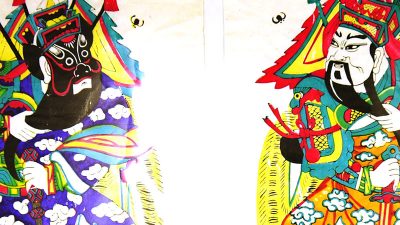Written by Cassie Lin
First of all, I would like to wish everyone a fabulous Chinese New Year! It’s only the 3rd New Year’s Day and traditionally it lasts 15 days (much more luxury than Christmas holiday I presume), there are still more red envelopes with lucky money in to come!
Last week, right before the Chinese New Year (also known as the Spring Festival), I came across some lovely old ‘Nian Hua’ (New Year Pictures) from the poster collection. Nian Hua is a traditional decorative art especially made for the New Year. It is fashioned back in the Tang Dynasty (618 -907 A.C.), originally made in a form of Chinese colored woodblock print (a very ancient technique) on textiles or rice papers. Nian Hua became extremely popular in the Qing Dynasty (1644 – 1912 A. C.), its significance can be equalled to the star on top of a Christmas tree. As each New Year arrives, customarily, every family replaces its Nian Hua in the household, in order to ‘Say Goodbye to the Past and Welcome the Future.’
‘Liu Hai Playing with the Toad’ (Nian Hua, likely dated late 1970s or early 1980s)
The popularity of Nian Hua started to decrease since the early 1990s. People, especially those in cities, were influenced by modern arts to see Nian Hua as aged and staid. Unfortunately, my family was part of them. Nian Hua never was a traditional New Year decoration in the household when I was growing up. (I did confronted my mum about it last week, and she defended, “I get thematic flowers and plants every new year.” Oh well.) So, you can imagine the fascination I had when discovering these dated Nian Hua in the Chinese Poster Collection, mythical characters and gods still vividly colored on delicate rice papers, so beautifully illustrated, too beautiful that I almost took them home for decorating the coming new year.
I was specially enchanted by Nian Hua of the Chinese Door Gods. They are often come in pairs to be placed on each side of an entry to a temple, home or business. The Door Gods are believed for keeping evil spirits from entering. Most of the two-piece Door God Nian Hua were separated in the poster collection, and I decided to put each pair into one melinex (Archival polyester sheets, for the transparent protection of manuscripts, comics, prints and drawings), so it’ll make more sense. I had a vague concept of the Door Gods but never know who they really are and what historical figures they refer to, and most importantly, how to pair them correctly.
‘The Door Gods: Qin Qiong and Jing De’ (Nian Hua, likely dated late 1970s or early 1980s)
For example, take a look at these two colourful door gods waving animated swords and riding on cute little ponies (a very efficient way to fight away the devils I believe), I had to google their names (as humiliated as it sounds), ‘Qin Qiong’ and ‘Jing De’, then learned they are these two generals from the Tang Dynasty. At the time, in order to award their excellent military achievement, Emperor Taizong ordered portraits of Qin Qiong and Jing De, for them to became the prototypes of the Door Gods. Traditionally, Qin Qiong is white-faced and should be placed on the left, while Jing De is the black-faced one on the right. (I am wondering if they would play the god cop/bad cop game when dealing with evil spirits.)
Nian Hua, likely dated late 1970s or early 1980s
The Door Gods later expanded into different characters and meanings over the years, such as the God of Wealth, the Kitchen God and all other genres for fulfilling people’s new year wishes comprehensively. It is a wonderful convention and for me, it’s worth keeping. Not for the purpose of superstition, but for people, especially younger generation, to learn a little lost history related to the Chinese New Year. If you still have some unreleased new year’s wishes, come to the Archive Service and meet our Chinese Door Gods, I’m sure they’ll be happy to help.
藏在英国大学档案馆的中国门神年画
小的时候,家里没有张贴年画的传统,后来留学海外,春节也难以与家人团聚,大抵是这些从前不曾留意的私人经历,致使我在中国宣传画收藏里翻出这些生产于上世纪七、八十年代的年画时,着实被惊艳到了。
年画源自于中国民间艺术,起源于汉代,发展于唐宋,盛行于明清,通常以一版一色的木版套印方法印刷而成。旧时的农历新年,人们盛行在室内贴年画,户上贴门神,以祝愿新年吉庆,驱凶迎祥。我仍然记得,从前外婆若夜里梦到小鬼,便会托家人买一副门神贴在家中,寓意逢凶化吉。
在这些收藏里,我最喜爱的,也是以门神为主题的年画。幼年时,对于门神的概念非常模糊,总觉那是迷信,不愿深入了解。直到今天,在档案馆找到这些产地、作者都已不祥的年画,才知晓正宗的传统门神应是唐代名将秦琼与尉迟敬德。两个武将,金盔甲胄,一持鞭,一执枪;一黑脸浓须,一白面虬髯。据《山海经》载称:唐太宗李世民生病时,梦里常听到鬼哭神嚎之声,以至夜不成眠。这时,大将秦叔宝、尉迟恭二人自告奋勇,全身披挂站立宫门两侧,结果宫中果然平安无事。李世民认为两位大将辛苦,心中过意不去,遂命画工将他俩人的威武形象绘之在宫门上,称为“门神”。(新华网 -《中国年画》)
在我心里,这些门神年画,简直可以和当代视觉艺术媲美。鲜艳的画面配色,以及独特的铠甲与武器设计,犹如波普艺术一般跳脱;武将们夸张的、超现实的面部表情,又有一点毕加索的影子。只可惜它们的作者,那些深谙传统年画绘制工艺的民间匠人,似乎早已无迹可寻。正因如此,摄政图书馆里,这一叠从失落的时光里被保存下来的门神年画,才显得尤为珍贵。
Cassie Lin is a doctoral student at the University of Westminster. She previously worked as an archive assistant at the University of Westminster’s Chinese Poster Collection, now renamed the China Visual Arts Project Archive.
- TV Drama Discourse on Stay-at-home Fathers in China: Super Dad & Super Kids - January 28, 2022
- Freud and China - January 20, 2022
- “Cultural China 2020″—A Different Take on China - January 7, 2022



